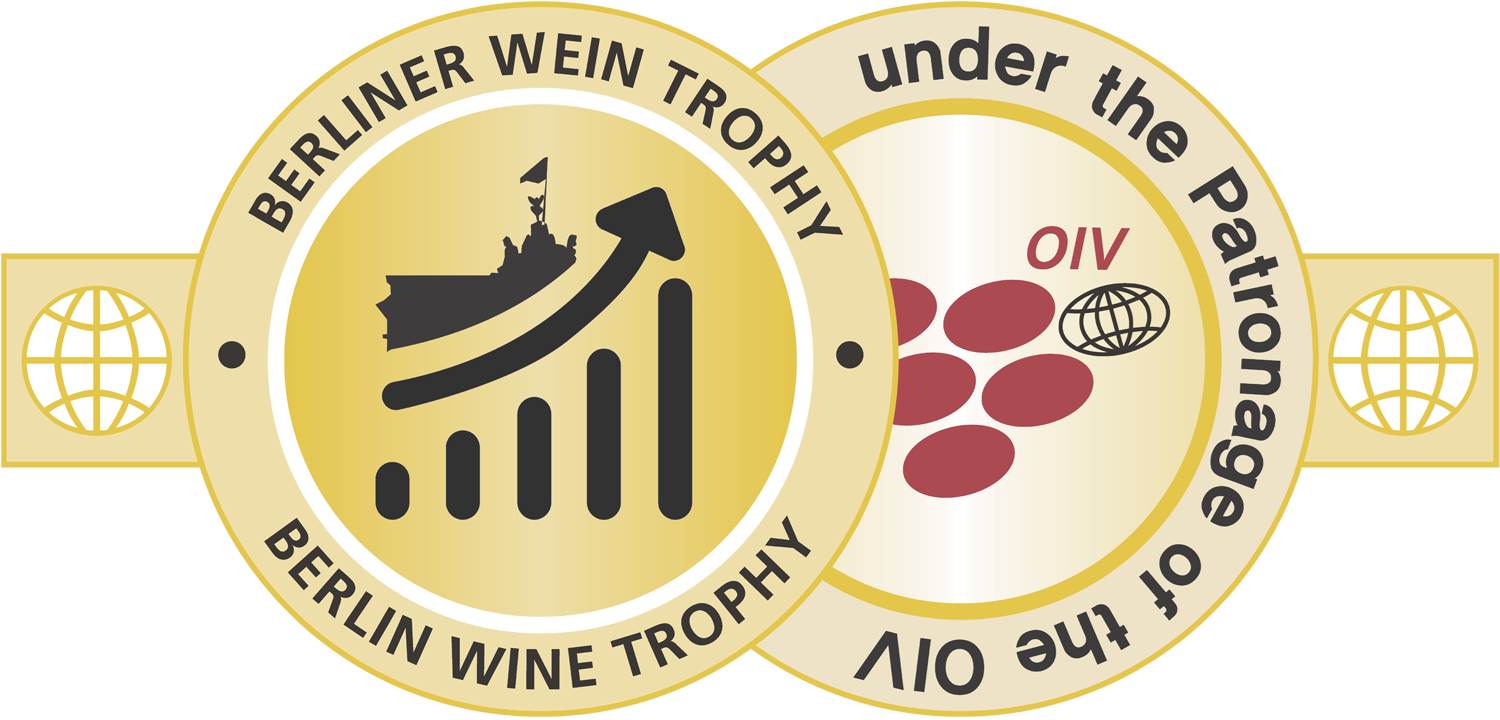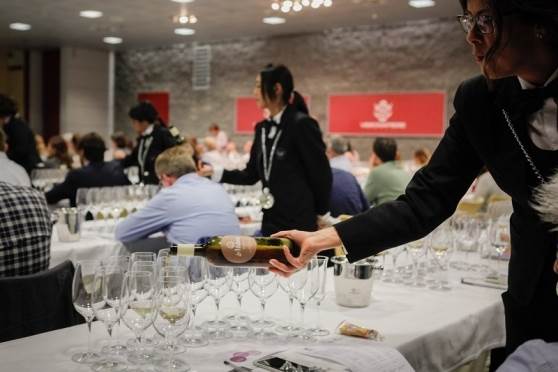TARGET – Who is the event for?
Wine competitions can be either national or international, general, directed towards some typologies of wine only (white, red, sparkling or raisin wines etc.), towards some vine varieties only (pinot, merlot etc.) or towards wines produced in some areas only (mountain areas, islands, within specific countries etc.). The first step is defining who the organizing body wants to organize the competition for.
NAME OF THE COMPETITION AND LOGO
Generally, the name of the competition includes the name of the place where it is organized and/or the name of the vine variety, or the name of the typology. It can also be made up as long as it is related to the wine world.
Therefore, the second step is to create a name and a logo.



DATE AND LOCATION – Where will the tastings take place?
An appropriate location with a “technical room” is to be chosen to host the competition. The location needs to be equipped with fridges for wines that have to be served cold (mainly white and rosé wines) and a place spacious enough in order to place there the bottles in the right sequences of tasting. There also needs to be an “official room” dedicated to the tastings.
Some contests provide one small table for each taster, some prefer to put each jury at the same table. That being so, it is important to take all that into account before choosing the ideal location.
As for the date, it is necessary to set a period in order to ensure continuity and create an annual or a biennial event. There also are “travelling-events” that are organized in different places for each edition, although under the same name, at the same date and for the same purpose.


REGULATIONS
Regulations are a set of rules which are the basis of the entire organization. Regulations are divided into articles containing the following details:
- Who organizes the competition
- Who the competition is for
- The purpose(s) of the competition
- Typologies and categories of wines admitted
- Terms of registration
- Shipping conditions for the participating wines
- Details related to the storing and the anonymity of the participating wines
- Who the tasting jury will be composed of
- Prizes and scores
- Possible Awards ceremony
- Possible legal notes
TASTING JURIES
Based on the number of wines entered in the competition, it will then be possible to determine the number of necessary tasting juries and to select expert tasters. For almost every competition, there is a President for each jury in charge of coordinating the teamwork. If it is a small-scale competition, it is possible to contact technicians of the sector that we know of or ask for contacts to sommelier, oenologist or wine specialist associations. In addition, it is always interesting to use social media (Facebook page) or websites to promote the competition on the one hand and to recruit wine-tasters on the other hand.
The competitions that want to benefit from the patronage of the OIV have to observe its regulations which stipulate that most tasters have to be enologists or wine experts and that at least 50% of the participants have to be foreigners. It should be noted that generally costs and expenses – regarding the tasters – are all paid for (journeys, accommodation and board), but tasters are not remunerated. Nevertheless, that role is highly coveted as it offers interesting benefits: opportunity to taste several wines – more or less prestigious – and expanding your CV.
POSSIBILITY TO APPLY FOR THE PATRONAGE OF THE OIV (International Organization for Vine and Wine)
The OIV is an intergovernmental organization. Known as a scientific and technical entity, it is well recognized for the work it carries out when it comes to vines, wines, wine-based beverages, table grapes, raisins and other vine-based products.
The OIV grants patronages to international or national wine and spirit competitions of vitivinicultural origin requiring such patronage and provided that their organization and internal rules procedures are in compliance with the international standards of the OIV.
http://www.oiv.int/en/the-international-organisation-of-vine-and-wine/oiv-patronage
Each organizing body can decide whether it is better for them to apply for the patronage of the OIV, in which case they have to send the regulations and the list of the tasters.


POSSIBLE PUBLIC OFFICER
In some European countries, as is the case in Italy, it is necessary to identify a Public Officer (lawyer or notary), outside the wine sector, who will be in charge of carrying out different functions of control and supervision. For example, he has to ensure the anonymity of the wines (see below) and check that the bottles are well stored from the receiving until the contest. Moreover, he has to check the exactitude in the execution of the tastings and, in the case of hand-made evaluations, he has to compare the scores and draw up the list of the winning wines.
WHO DEALS WITH THE TASTINGS?
The organizing body of the competition will decide who will deal with the tastings. It is possible to charge its proper staff or to assign the task to a sommelier association, to the students of catering institutes etc. The individuals in charge will have to keep the wines at an ideal temperature and pour them to the tasters according to the pre-established sequence.


WEBSITE OF THE COMPETITION
It is recommended but not mandatory to create a website for the competition exclusively, on which the registrations will be submitted and all the details of the event will appear, as the list of the tasters and the list of the winning wines.
DATABASE
A database containing a mailing list with all the contact details of potential and real participants has to be created. This database will then be used for all communications during and after the competition and also for future editions.
If the organizing body does not have this contact list, it will take time to gather all the contacts. It will then be necessary to either find them using Internet or ask associations of wine producers in order to be able to gather them.
DISSEMINATION
The dissemination of the competition has to start a few months ahead of the event, once the main details are set up (purpose, name of the event, date, location, etc.) and it should be done using all tools available such as websites, emails, social networks and so on.
PRESERVATION OF THE BOTTLES
It is important to settle a location in advance that is well suited to store the participant wines that will be arriving bits by bits, up until the moment of the tastings. The good management of the bottles as for the storage modality as for the preservation conditions represents an important aspect in the organization
REGISTRATIONS
It is necessary to create a file for the registrations, on which the following data have to appear:
- Name of the winery, address and country, phone number, email address, website;
- Information about the registered wines (denomination, category, year, alcohol content, sugar residue, etc.)
ANONYMIZATION
In order to ensure the anonymity of the wine samples, it is necessary to attribute a number to each wine according to the registration order. As the bottles arrive, the assigned number has to be written on each of them.
In several cases, a second anonymizing step is done and another number is given to each wine. If there is a Public Officer, formally chosen by the organizing body, he will deal with that before the samples are presented to the tasting juries and he will check the storing of the wines from the moment they are made anonymous up until the drafting of the list of the winning wines. If there is no public officer, the organizing body will deal with all of the above itself.

EVALUATING SYSTEM OF THE SAMPLES
It is necessary to decide and set up an evaluating system for the samples that will be used by the tasting juries.
The traditional system either by hand or computerized can be used.
In both systems, each taster will have a form set up by the UIOE, International Union of Oenologists, which will have to be filled in for each tasted wine, by hand in the traditional system and on a tablet in the computerized one.
In the case the computer system is opted for, an outside company will have to be picked out. It will provide the tasters with a tablet together with the program calculating the scores assigned to each tasted wine.
Each wine can reach a maximum score of 100 points.
There are different methods of calculation to establish the final score of each tasted wine:
– weighted average, the highest and lowest scores are eliminated and it is made the average of the remaining ones;
– average of all scores;
– median, it is used the central score of the assigned scores.


WINE FLIGHTS
Once the registrations are closed, it is possible to establish the sequences of wines to be tasted, so called “flights”. They are judged by juries made up of 5/7 tasters each who can usually taste up to maximum 50 wines per day. The flights are generally composed by about 20 wines and between the flights it is usually necessary a break of 15 minutes.
Constituting the flights when the participating wines are single-varietal is easier because the sequences are mainly chosen by year, then by alcohol content and finally by sugar residue.
However, in general competitions, in which wines of different typologies participate, the preparation of the series is trickier: wines are firstly divided by vine varieties, then by area of production, etc.
Based on the number of wines registered and based on the fact that it is not possible to taste more than a certain number of wines per jury, the number of juries or the duration of the competition will be increased
POSSIBLE ACCOMODATIONS AND TRAVEL COSTS FOR TASTERS
If tasters came from far away, it should be necessary to set up an accommodation for them and, if they have to reach the location of the tastings by train, by bus or by plane, the organizing body should have to deal with the reservation and the payment of their travel costs.
BOARD FOR THE TASTERS
If the competition lasts more than one day, it is a good practice to organize lunches, dinners, breaks and visits on the territory, considering that juries are generally composed of foreign tasters.
COVER THE LABELS OF THE WINES AND DIVIDING THEM BASED ON THE ESTABLISHED SEQUENCES
Generally, one day before the competition is necessary to bring the wines to the location where they will take place the tastings for the selection of the wines. If the bottles have to be tasted cold, they will have to be put in fridges.
The bottles of the samples, previously numbered, have to be covered in order to make the wines anonymous, generally wrapping them in specific bags. If there is only one number attributed to each bottle, the number will be reported on the bag containing the wine; if the wine is made anonymous with a second number, each number of each bottle will correspond to another number appearing on the bag.
In some competitions which use the computerized system, it is now used a new system by which each tasted wine has a bar code connected to the evaluation system.
